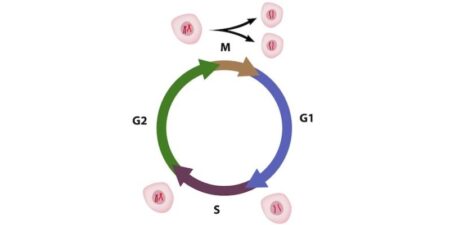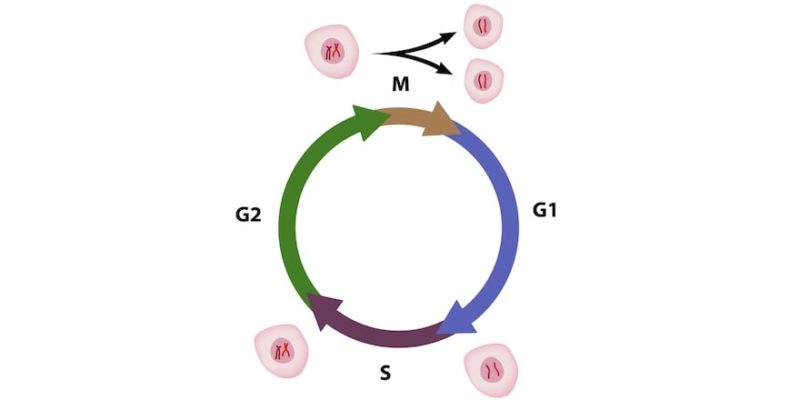We explain Cell Cycle Stages. Cell division is one of the most important biological processes that exist. Since the cell is the anatomical, physiological, and original unit that makes up all living beings, it is not surprising that its vital and reproductive cycle is essential for all forms of life to survive.
Cells can proliferate and fulfill their functions thanks to each of the phases that make up the cell cycle. Any damage, abnormality or mutation that occurs during any of these phases could trigger syndromes or diseases such as Down syndrome and cancer.
The cell cycle is the ordered and sequential set of events that take place within all cells in general. They involve their growth and eventual reproduction in two “daughter” cells . This process is essential for the existence of multicellular beings .
Cell Cycle Stages.

The cell cycle is not linear, but circular, since young cells can choose to repeat the process , thus creating two new ones each, as needs dictate. And broadly speaking, the different stages that comprise it are organized based on two separate phases, which are:
- The interface. This first phase comprises the G1-S-G2 stages, and during them it grows to its proper level to start duplicating its genetic material, completely copying it according to its DNA .
- Gap Stage 1.The cell physically grows, duplicating its organelles and the proteins necessary for the following stages.
- Stage S.A complete copy of the cell’s DNA is synthesized, as well as a duplicate of the centrosome, which will help separate the DNA at later stages.
- Gap Stage 2.The cell grows even larger, makes new proteins and organelles, and prepares for mitosis, cell division.
- The M phase.The mitotic phase begins when the cell has already duplicated its genetic material and organelles, ready to divide into two identical individuals. The beginning of mitosis starts with the separation of the DNA into two double strands, and the two new cell nuclei move away from each other, towards opposite poles.
M phase is divided into four distinct phases: prophase, metaphase, anaphase, telophase .
Thus, when cytokinesis begins, which is the preparation for the final separation of the two new cells, each nucleus remains separate. A barrier begins to be generated between the two cells, which will later become part of the plasma membrane itself , and finally the physical separation occurs.
Regulation of the cell cycle
The cell cycle must occur under very specific conditions , which require very specific control and regulation instances. So that without precise instructions, not only does the entire cycle not start, but the transition from one stage to the next will not occur.
In the first instance, control is exercised by genes in the cell’s own genetic code . There are instructions for making or modifying proteins to trigger each stage of the cycle. The set of enzymes that activate, facilitate, or terminate each phase are the cyclins and cyclin-dependent kinases .
Cell Cycle Checkpoints
The p53 protein repairs DNA during the cell cycle.
There are, especially during mitosis, a series of checkpoints in the cell cycle, where the process is monitored and it is ensured that no errors have been made. These are transitory existence verification routes , that is, once their function has been fulfilled and it has been verified that the process continues without errors, they disappear.
Furthermore, in the event that the problem, after a period of time, has not been satisfactorily resolved, these checkpoints prepare the cell to undertake self-destruction or apoptosis .
Checkpoints during mitosis are:
- At the end of the G1 stage and before the S stage.This is the checkpoint for unreplicated DNA, which inhibits the Cdc25 gene, which in turn activates Cyclin A/B Cdk1. Thus, it prevents the cycle from continuing.
- Before anaphase in mitosis. It is a checkpoint that guarantees the separation of the chromosomes, and it operates by activating the Mad2 protein that prevents the degradation of segurin, until the conditions are appropriate.
- DNA damage checkpoints in G1, S, or G2. In the event that cell damage occurs, specifically to the genetic material, the p53 protein will be activated, which allows DNA repair. Should this fail, the apoptosis processes are immediately activated.
Importance of the cell cycle
The cell cycle is the fundamental cycle of reproduction of cells, which allows the growth of multicellular organisms and the repair of tissues . In addition, it causes the necessary proliferation to, for example, generate the critical cell mass to form embryos of future new individuals of the species.
It is a process that is carried out constantly . It is encoded in our DNA itself, so it is one of the fundamental and original cycles of eukaryotic cell life.
Cancer and the cell cycle
As is known, cancer is a disease in which certain cells of certain tissues initiate an abnormal , unstoppable reproduction of dysfunctional cells. This process, which may well cause death if not stopped in time, is not interrupted by the natural process of cell apoptosis, and therefore requires medical intervention.
Many specialists suggest that the start of the carcinogenic process is in certain genes that regulate the cell cycle that do not work well or have been damaged, subjecting the process to a lack of control that in turn engenders other failures and culminates in the formation of a tumor. These genes are known as oncogenes, and their precursors as protoncogenes.
